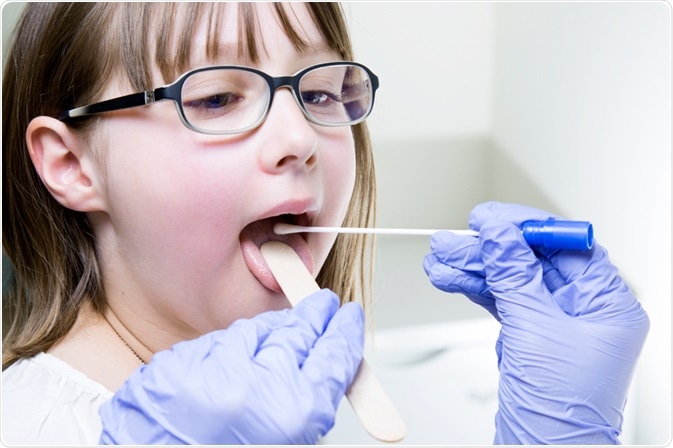Acute sore throat represents a common cause of primary healthcare and emergency consultations, particularly in the pediatric population. The most common bacterial cause is beta-hemolytic group A streptococcus or Streptococcus pyogenes, which is the reason why this inflammation is also known as “strep throat.”
Since the signs and symptoms of streptococcal pharyngitis can significantly overlap with other causes of sore throat, establishing a diagnosis solely on clinical findings can be a daunting task. Therefore, accurate clinical assessment of acute pharyngitis remains pivotal in choosing further laboratory tests, determining optimal treatment approach, as well as avoiding the overuse of antibiotics.

Image Credit: Doro Guzenda / Shutterstock.com
Clinical criteria for diagnosis
Clinical manifestations of streptococcal pharyngitis in adults are similar to those in children, with the absence of abdominal pain and vomiting, both of which are features that can occur in children. Physical examination usually reveals pharyngeal erythema, with anterior or posterior adenopathy, swollen uvula, and palatal petechiae (pinpoint red spots).
Nevertheless, it must be emphasized that no single element of the clinical presentation can reliably confirm or exclude pharyngitis caused by Streptococcus pyogenes. Sore throat, sudden fever (with temperatures greater than 38 °C or 100.4 °F), as well as exposure to beta-hemolytic group A streptococcus within the previous two weeks are highly suggestive of strep throat.
The original Centor score is comprised of four signs to predict a positive throat culture for Streptococcus pyogenes in adults with acute pharyngitis. These features include a history of fever, tonsillar exudate, cervical lymphadenopathy, and the absence of cough.
The cumulative score then determines the likelihood of strep throat and whether there is a need for antimicrobial therapy. According to this system, patients with a score of zero or one are in a low-risk group for streptococcal pharyngitis, thus they do not require additional testing or antibiotics.
On the other end of the spectrum are patients with a score of four, who may be given an empiric therapy, as they are considered at high risk for the disease. Individuals with a score of two or three should be tested by adequate laboratory methods, with positive results justifying antibiotic treatment.
Laboratory diagnostics
As the signs and symptoms of streptococcal pharyngitis can overlap with those caused by other pathogens, a definitive diagnosis necessitates laboratory confirmation by either a throat culture or a rapid antigen detection test. The evaluation of streptococcal antibody titers is particularly useful for diagnosing acute streptococcal pharyngitis; therefore, these serological tests are indicated when there is a need to confirm the previous infection in individuals with post-streptococcal sequelae.
With an adequate sampling approach, a conventional blood-agar plate throat culture from a single swab is considered to have a sensitivity within the range of 90% to 95%. One disadvantage of this method is the delay (overnight or even longer) in obtaining a definite diagnosis.
Conversely, a rapid antigen detection test can detect the presence of group A streptococcal cell-wall carbohydrate directly from the throat swab within minutes, with specificity ranging from 90% to 99%. Although the sensitivity of older rapid antigen detection kits was only about 70%, newer optical immunoassays and enzyme-linked immunosorbent assays (ELISAs) are much more sensitive.
Nevertheless, confirming negative rapid tests by a conventional throat culture is still practiced. However, certain experts think that the gain in sensitivity does not justify the additional cost and inconvenience, nor does it necessarily translate into better patient outcomes in areas where the incidence of acute rheumatic fever is quite low.
References
Further Reading
Last Updated: Apr 24, 2021